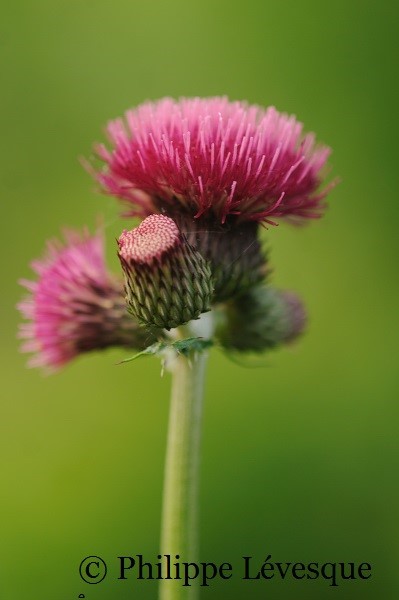Plantsman's Corner: Cirsium rivulare 'Atropurpureum'
'It is my own fault if I idealize a thistle until the thistle and I both think it is a vine,' wrote Mary Cholmondeley in her Victorian novel Red Pottage. One may be forgiven to surmise that the famous icy blue clematis that bears her name was so called in this quote's honour, but alas Mr. Noble named his vine a good 13 years before the famous passage was written. One wonders if Mrs. Cholmondeley was serious when she suggested she liked thistles so much as to idealize them. History does not tell, but it is clear that not everyone in her time liked thistles. A hundred and fifty years ago, when life still depended largely on cultivating the land with horse and plow, they represented challenges to the farmer who struggled to eradicate them from his field. Sheep or cows find them too prickly on the tongue, forgoing them altogether. The propensity thistles have in colonizing pastures anew with their abundant seeds or questing roots bristled the American political leader Robert Green Ingersoll to say that “The destroyer of weeds, thistles, and thorns is a benefactor whether he soweth grain or not.”. Perhaps he was not aware of the beneficial aspects thistles have on the ecology of meadows and wastelands. He may not have tasted the delicious pale honey made from their nectar or the beauty of their flowers. Ellen Willmott, the eccentric horticultural heiress would have disagreed with him on at least one thistle that she particularly liked and, it is rumoured, spread around gardens that she visited. Erygnium giganteum is now affectionately called Mrs. Willmott's Ghost' as a result of her seed scattering efforts, a rebellious act deemed guerrilla gardening today.
If I wanted to emulate Mrs. Willmott's defiant act with my own favourite thistle, Cirsium rivulare 'Atropurpureum', the effort would be fruitless since it is a sterile plant producing no seeds whatsoever. Cirsium rivulare 'Atropurpureum' is remarkably well behaved for it is reliably perennial, floriferous and self-supporting without the conquest ambitions of other thistles. In our garden, it starts blooming with camassias, early geraniums, Siberian irises and Martagon lilies and will go on flowering until severe frosts silence the show. Because the raspberry-red flowers beg for silver leafed plants, we too have planted the thistle with Salix exigua and shimmering pink Geranium psilostemon ‘Rose Finch’ to great effect. It would look stunning with the lacy Ammi majus ‘Queen of Africa’ and the sapphire spires of Anchusa azurea ‘Loddon Royalist’. Cirsium rivulare 'Atropurpureum' makes a superb cut flower, especially as its side shoots are of sufficient lengths for arrangements without compromising the plant's growth. Its brushes are a unique crimson red that blends well with other colours, offering that touch of dark refinement often needed in floral arrangements.
“Rivulare”, meaning “of the riverside” hints at the cultural preferences for Cirsium rivulare 'Atropurpureum'. In dry soils, plants will be stunted, becoming poor semblances of their counterparts in rich, moist soils. Deadheading will be inconsequential since the plant is sterile, flowering continuously until summer heat exhausts it. Flowering will resume in autumn to accompany the New England asters and sunflowers.
European horticulturists and garden designers have wholeheartedly embraced Cirsium rivulare 'Atropurpureum' for its richly saturated wine-red flowers. Dan Pearson has used it very effectively at Home Farm where he planted it with glowing orange Eremurus. Cirsium rivulare ‘Atropurpureum’ featured prominently in Arne Maynard and Piet Oudolf’s 2000 Chelsea Flower Show garden’s mixed borders of Astrantia major ‘Claret’, Centranthus ruber ‘Coccineus’ (red valerian), and dark-leafed Actaea. At the Battersea Park's Old English Garden, the young British garden designer Sarah Price uses Cirsium rivulare 'Atropurpureum' with Cenolophium denudatum (Baltic parsley), salvias, and scented herbs.
Unfortunately its availability in North America is limited. We imported our stock years ago from Great Britain and we sell out every spring. As Cirsium rivulare ‘Atropurpureum’ is one of our most requested plants and demand far outweighs the supply. We hate disappointing clients, so it has been a challenge to keep sufficient stocks through the years. Cirsium rivulare ‘Atropurpureum’ does divide easily and increases steadily but since division is our only mean of propagation (root cuttings have never worked, despite what literature says), it does take time to build stocks. Perhaps one day it will be micropropagated and we can use it with wild abandon!

Even scarcer still is the other known cultivar 'Trevor's Blue Wonder'. A sport of 'Atropurpureum', it was recently been introduced to the horticultural world by the British gardener Trevor Edwards. We have not had the opportunity of growing it yet, but it is reputedly an equal stalwart in the garden as 'Atropurpureum', its difference lying in its bright purple colour rather than crimson, an easier hue to combine with some pinks and yellows. ‘Trevor’s Blue Wonder’ should be a welcome new addition that will no doubt sustain the popularity of this thistle for years to come. No doubt both Mrs. Cholomondeley and Mrs. Wilmott would have approved and, we hope, perhaps even Mr. Ingersoll.
~ Philippe and Eric








